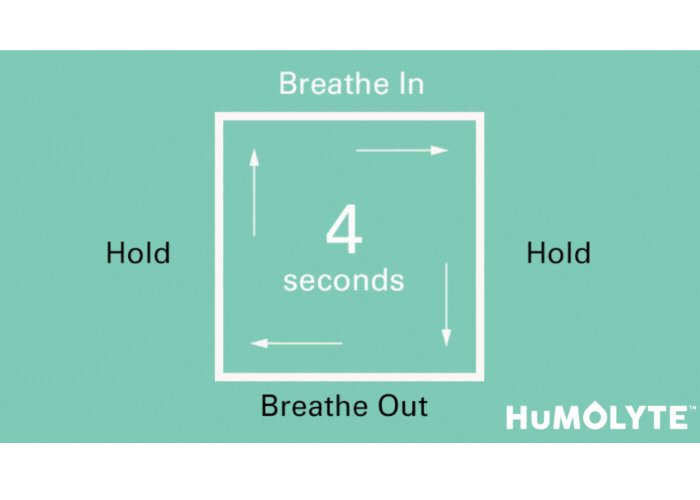Blog
Hope
A poignant anecdote highlights the impact of framing in cancer treatment outcomes. Two oncologists used identical chemotherapy regimens—Etoposide, Platinum, Oncovin, and Hydroxyurea—but observed markedly different patient response rates: 22% versus 74%. The key difference lay in their communication; one physician referred to the regimen as "EPOH," while the other presented it as "HOPE," emphasizing the potential for positive outcomes. This underscores the significant role that conveying hope and optimism can play in patient responses to treatment.
Box Breathing: A Navy SEAL Technique for Cancer Patients and Loved Ones to Reduce Stress
Box breathing, also known as square breathing, is a simple yet effective technique that involves inhaling, holding the breath, exhaling, and holding again, each for a count of four. This method engages the parasympathetic nervous system, promoting relaxation and reducing stress. Practicing box breathing can lower heart rate, enhance focus, and improve emotional regulation, making it particularly beneficial for cancer patients and their loved ones managing the emotional and physical challenges of treatment. Incorporating this practice into daily routines can provide a sense of control and calm during stressful moments.
Understanding Hair Loss During Cancer Treatment: Myths, Tips, and Resources
Hair loss during cancer treatment, particularly from chemotherapy, occurs because these treatments target rapidly dividing cells, including hair follicles. The extent of hair loss varies depending on the type and dosage of treatment. Managing hair loss involves using gentle hair care products, considering scalp cooling caps to reduce hair loss, and exploring wigs or head coverings for comfort and style. Hair typically regrows after treatment, though it may initially differ in texture or color. Support resources, including wig programs and support groups, can help patients navigate this temporary but challenging side effect.
HuMOLYTE: A Solution Amid the IV Fluid Shortage for Chemotherapy Patients
The nationwide shortage of intravenous (IV) fluids has significantly impacted hydration management for chemotherapy patients, who are particularly susceptible to dehydration due to treatment-related side effects like nausea, vomiting, and diarrhea. In response, healthcare providers are turning to oral hydration solutions as viable alternatives. HuMOLYTE offers a practical option, combining electrolytes and prebiotics to effectively rehydrate the body and support gut health. This approach not only alleviates the strain on limited IV fluid supplies but also empowers patients to manage their hydration needs at home, ensuring continuity of care during these challenging times.
Dancing Through Cancer: How Losing My Leg Led Me to the Screen
At 18, I faced a life-changing diagnosis of bone cancer, enduring two years of chemo, losing my leg, and overcoming six tumors. But cancer couldn’t stop me. From dancing on Soul Train to acting on Northern Exposure and Beverly Hills 90210, I found new passions and joy. My journey taught me perseverance, character, and hope—lessons I carry with gratitude and a love for life.
Understanding Chemotherapy-Induced Dehydration: Causes, Risks, and Solutions
Chemotherapy can lead to dehydration through side effects like nausea, vomiting, diarrhea, and reduced fluid intake due to mouth sores or fatigue. This dehydration may cause fatigue, electrolyte imbalances, kidney strain, and cognitive issues. To mitigate these risks, patients should aim to drink 8–10 cups of fluids daily, consume hydrating foods such as watermelon and cucumbers, monitor their fluid intake, and promptly address side effects with their healthcare provider. Limiting caffeine and alcohol is also advisable, as they can contribute to fluid loss. Recognizing early signs of dehydration, such as dry mouth, dark urine, dizziness, and fatigue, is crucial for timely intervention and maintaining overall health during treatment.
The CAUTION Signs: 7 Cancer Symptoms You Shouldn't Ignore
Early recognition of cancer symptoms is vital for timely intervention. The American Cancer Society highlights key warning signs with the acronym CAUTION: changes in bowel or bladder habits, a sore that doesn’t heal, unusual bleeding or discharge, thickening or lumps, indigestion or swallowing difficulty, changes in warts or moles, and persistent cough or hoarseness. Persistent symptoms should be promptly evaluated by a healthcare provider.
How COVID-19 Led to a Cancer Research Breakthrough
Recent research has identified a novel immune cell type, inducible nonclassical monocytes (I-NCMs), which exhibit significant anti-cancer properties. These cells can infiltrate tumor sites and recruit natural killer cells to attack cancer cells, showing potential against melanoma, lung, breast, and colon cancers. This discovery offers a promising avenue for developing treatments, especially for cancers resistant to existing therapies.
Gut Health and Chemotherapy: Why It Matters and How to Support It
Chemotherapy can disrupt the gut microbiome, leading to side effects like diarrhea, constipation, nausea, and inflammation, which may compromise immune function and nutrient absorption. To support gut health during treatment, patients are advised to stay hydrated, consume prebiotic-rich foods such as bananas, garlic, avocados, and oats, and include probiotic-rich foods like yogurt and fermented products in their diet. These practices can help maintain a balanced gut microbiome, potentially alleviating treatment-related side effects and enhancing overall well-being.
Understanding Cancer Staging: What the Numbers Really Mean
Cancer staging is a system used to describe the extent of cancer in the body, guiding treatment and predicting outcomes. The TNM system evaluates the size and spread of the tumor (T), lymph node involvement (N), and metastasis (M). Stages range from 0 (localized, non-invasive) to IV (advanced, metastatic cancer). This classification helps healthcare providers tailor treatment strategies and assess prognosis, with criteria varying by cancer type.
High-Dose Vitamin C Shows Promise in Treating Pancreatic Cancer
Recent research indicates that high-dose intravenous vitamin C, when combined with standard chemotherapy, may significantly improve survival rates for patients with late-stage metastatic pancreatic cancer. A randomized phase 2 clinical trial demonstrated that patients receiving this combination therapy had a median overall survival of 16 months, compared to 8 months for those receiving chemotherapy alone. The high concentrations of vitamin C achieved through intravenous administration are believed to generate hydrogen peroxide, which selectively targets and kills cancer cells while sparing healthy tissue. These findings suggest that integrating high-dose vitamin C into treatment protocols could enhance outcomes for pancreatic cancer patients, though further research is needed to confirm these results.
10 Foods to Avoid During Chemotherapy
Packing a well-thought-out chemotherapy bag can help make treatment sessions more comfortable and manageable. Essentials include hydrating beverages, nutritious snacks, a cozy blanket, books or entertainment for distraction, personal care items like lip balm, and headphones for relaxation or privacy. These thoughtful items ensure a more positive and prepared treatment experience.
Nutrition & Exercise During Chemotherapy Reduce Ovarian Cancer Hospital Stays
A study published in Scientific Reports examined the impact of nutrition and daily habits on recovery times for ovarian cancer patients undergoing chemotherapy. Key findings indicated that low protein levels, high nutritional risk scores, insufficient sleep, and limited physical activity were associated with longer hospital stays. Encouragingly, patients receiving proper nutritional support, particularly through enteral nutrition, experienced shorter hospitalizations. As treatment progressed, improvements were noted in nutritional risk, diet quality, physical activity, and daily step counts. The research underscores the importance of comprehensive care approaches that include regular nutritional monitoring, early nutritional support, encouragement of physical activity, and attention to sleep quality, suggesting that such holistic strategies can enhance treatment outcomes and reduce hospital stays for ovarian cancer patients.
How My Sick Kitten Taught Me to Heal: A Cancer Survivor's Journey of Hope
A cancer survivor found profound healing through caring for a sick feral kitten named Flora, who was diagnosed with feline leukemia. Initially, the survivor focused solely on physical recovery, neglecting emotional well-being. However, nurturing Flora fostered a deep bond, teaching the survivor that true healing encompasses both physical and emotional aspects. This journey led to exploring alternative therapies and embracing a more holistic approach to health, ultimately transforming their perspective on life and recovery.
How Does Chemotherapy Work?
Chemotherapy employs cytotoxic agents to target and destroy rapidly dividing cancer cells. These agents work by damaging the DNA of cancer cells or inhibiting their ability to divide, leading to cell death. However, chemotherapy can also affect healthy cells that divide quickly, such as those in hair follicles, the digestive tract, and bone marrow, resulting in side effects like hair loss, nausea, and fatigue. Despite these challenges, chemotherapy remains a cornerstone in cancer treatment, often used in conjunction with surgery and radiation therapy to improve patient outcomes.
The Overlooked Organ That Could Be Your Body's Cancer Defense
The thymus, an often-overlooked organ, plays a vital role in cancer defense by producing immune cells that help combat the disease. Recent research highlights that adults who have had their thymus removed face increased cancer risks and mortality, emphasizing the importance of preserving this organ whenever possible to maintain a robust immune system.
How To Talk To Someone With Cancer
When talking to someone with cancer, it's important to listen actively, avoid clichés or unsolicited advice, and focus on providing support and empathy. Simple, open-ended questions like "How can I help?" or "What do you need right now?" can foster meaningful conversations while showing genuine care and understanding.
Staying Hydrated During Cancer Treatment: A Patient's Guide
Staying hydrated during cancer treatment is essential for managing side effects and supporting recovery. Patients are encouraged to drink water regularly, include hydrating foods like fruits and vegetables, and opt for electrolyte-rich beverages to replenish lost minerals. Proper hydration helps maintain energy, reduce treatment-related complications, and promote overall well-being.
Veterans Cancer Risk Guide: What Service Members Must Know
Military veterans face elevated cancer risks due to service-related exposures such as Agent Orange, asbestos, radiation, and burn pits, which are linked to cancers like prostate, lung, and mesothelioma. To mitigate these risks, veterans are encouraged to engage in regular screenings, disclose military health histories to providers, and utilize VA resources for healthcare and support. Early detection and informed care can significantly improve outcomes and ensure veterans receive the support they need.
Study: Cancer-Related Cognitive Problems Can Improve Over Time
Studies reveal that cancer-related cognitive problems, often referred to as "chemo brain," typically improve over time. While patients may experience challenges like memory lapses and difficulty concentrating shortly after treatment, cognitive functions often return to near-normal levels within a few years, offering hope for long-term recovery.




















